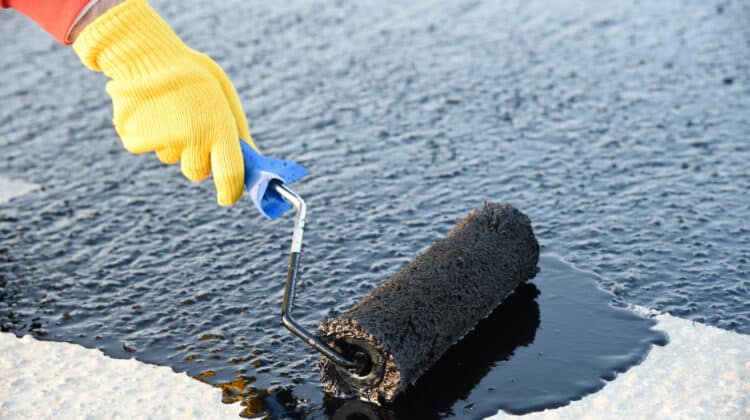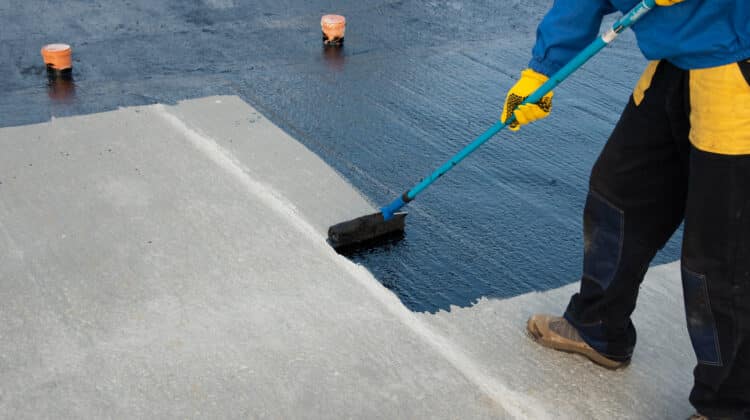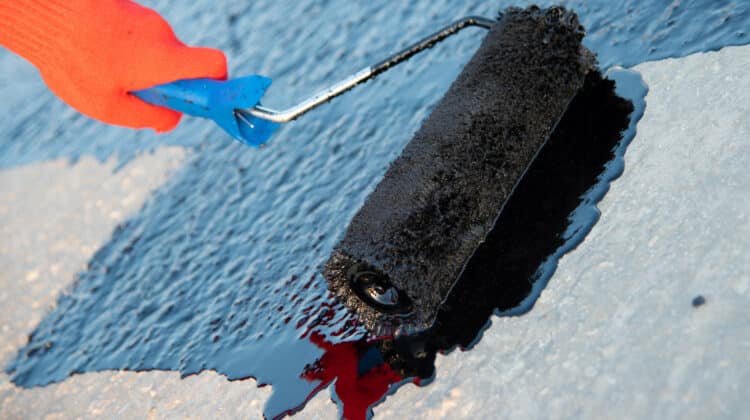Do you want to learn how to apply roofing cement?
In time, many things will occur to your roof from wear and tear, harsh weather elements, or simple neglect.
Shingles will loosen, cracks and gaps begin to appear, so you need to do something quickly. Or else, the holes will become bigger, and the water leaks will be pouring instead of just dripping out the ceiling.
These issues can easily be fixed by roofing cement, and putting on it in the right area with the proper amount will be a long-lasting repair.
Table of Contents
What are the steps in applying roofing cement on your roof?
You have the option of hiring a professional roofer to fix your roof, but if you want to do it yourself, here are the steps below.
Important tip in applying roofing cement:
Before using the roofing cement to patch up outdoors below sixty-five degrees Fahrenheit, make sure you store it in a relatively warm area indoors for twenty-four hours.
- Clean up the roof area for patching
- Applying the roofing cement
- Patching up larger holes on the roof
Before the patching up process begins, remove any dirt, debris, or moisture on the spot to be repaired. These will reduce the durability and adhesion of the roofing cement.
Apply a generous helping of the roofing cement and not a thin layer. Use a putty knife or trowel to force it into small gaps and crevices and spread it out evenly.
If you are using a kind of roofing cement with wet-surface formulas, work it through the surface around the spot. Smooth out a thin one-eighth inch coat over the area.
If you intend to apply a second coat, you need to wait for another twelve hours to allow for it to dry.
If you are patching up a roof blister, let it dry completely before spreading the roofing cement.
For sealing flashing, apply about one-half inch roofing cement.
If your roof has bigger holes, the roofing cement may not work alone. You may have to install fabrics like roll roofing first before applying it. If you want something sturdier, you can use fiberglass or polyester fabric instead.
You can also install underlayment, plywood, or even shingles for extreme situations.
Before applying the roofing cement, bridge the holes with your preferred material. Then generously coat the patch and press it steadfastly on the damaged spot.
One gallon of roofing cement can provide coverage for twelve square feet at a thickness of one-eighth inches.
How long will roofing cement dry?
How long roofing cement dries will depend on the weather condition and roofing materials. But on average, the trying time is twelve hours, and a complete cure takes twenty-four hours.
How can you remove roofing cement?
There are a few many to remove roofing cement on your roof:
- Use a razor’s edge or chisel to scrape or pry cement stuck on the roof
- Lift the shingles to remove cement beneath
- You can sand away remaining cement on flat surfaces like flashing
- Modern cement do not have asbestos, but old ones do, so if you are unsure of its removal, consult a professional
- Use WD-040 to remove roofing cement from your hands, then rewash them with strong soap and water
What is roofing cement made of?
Roofing cement is an adhesive material with many uses in the household or construction environment. It is mostly used to patch up surfaces and fix leaks and holes in a roofing system.
Roofing cement is available in many formulas but generally comes from refined mineral spirits, emulsified asphalt, reinforcement fibers, and plasticizing agents. Modern ones do not include asbestos anymore.
Newer roofing cements formulas can now be applied in wet surfaces, but the regular ones still work effectively in applying to dry areas.
What are the other uses of roofing cement?
Besides patching up holes, roofing cement has other uses:
- It repairs rust spots
- It secures joint attachments in gutters
- It secures leaking metal trims
- It plugs up leaks in flashing that surrounds valleys, coping, and chimneys
- It holds down loose shingles
- It fills in concrete cracks
What are the types of roofing cement?
As mentioned, all kinds of roofing cement include mineral spirits, asphalt, plasticizers, and reinforcing fibers. Yet there is various roofing cement used for different situations.
There are types specifically formulated for wet or dry surfaces, and many are available in the market today.
There’s so many brands available, and to pick the best one, it is recommended to consult with a professional roofer and constructor to determine the most effective one for your situation. If you intend to hire their services, they already have the required knowledge to decide the best roofing cement for your roof.
Do not use roofing cement in these situations
Whenever leaks occur in households, homeowners might become desperate, and immediately use roofing cement to patch it up. They have to remember that it is not a permanent fix and might be doing more harm than good.
There are places in a particular home that are structurally integral yet delicate, like chimneys, skylights, walls, and underneath shingles. Leaks can easily develop in these spots because the water current can be restricted, which will result in pooling and damage.
You must not utilize roofing cement in these circumstances:
- Do not use as a substitute to roofing nails
- Do not use as a permanent patch
- Do not use as an alternative for underlayment
Roofing cement is supposed to be only a temporary patch-up repair to leaks, holes, and gaps in your roof. It deserves a permanent solution that can only be provided by a professional roofer or contractor.
A particular roofing system in a household will depend on each layer to function and prohibit water from channeling inside the home. If one layer is damaged like the underlayment or shingles, the whole system is compromised.
Roofing cement will work to stop water in its tracks for now. However, you will still need to replace the damaged piece in your roof for the whole roofing system to be secure.
Are there materials that roofing cement is not compatible with?
While roofing cement is regarded as a multi-purpose roofing adhesive, there are some materials that they cannot combine with:
- PVC or polyvinyl chloride can be damaged once it combines with roofing cement
- EPDM or ethylene propylene dine monomer is a synthetic rubber roofing and needs a silicone-based adhesive to bind with the roof am not roofing cement which can also damage
Always practice work site safety
All types of roofing tasks have a level of risk involved. Even though patching up the roof using roofing cement seems like an easy job, many things can go bad.
If you intend to do the roofing job, you must always follow safety procedures and use proper roofing safety equipment.
FAQ or frequently asked questions about how to apply roofing cement
Is roofing cement waterproof?
Yes, roofing cement is made to be waterproof and has a substance that can prevent leakages and keep the surface underneath dry.
As time passes and exposure to the weather elements, it will become dry, break up, and lose its waterproofing capability.
Which is better: professional or DIY roofing?
Many homeowners might want to turn a roofing task into a DIY project. However, if you do not have experience with roofing, it is better to leave it to professionals.
Why is structural integrity important in a roofing system?
Structural integrity is a principal reason it is better to leave roofing work to professionals. Since the roof is a crucial component of the structure of your home, it should maintain its structural integrity.
If you have no roofing experience and attempt to fix or replace the roof on your own, you might not notice a more necessary in-depth repair. It may result in a structural damage in the future, which should be avoided.
The roof provides safety and security for the household, so replacing or fixing it should not be taken lightly and skimped on, even if it is just a minor problem. A professional roofer or contractor should always be the best solution for even a roofing cement patch-up.
Does learning how to apply roofing cement matter?
Even though you will end up hiring a professional to patch up your roof with cement, learning how to apply it on your roof is still necessary.
When a situation demands that you have to climb up and patch up the roof, you already know what to do.





